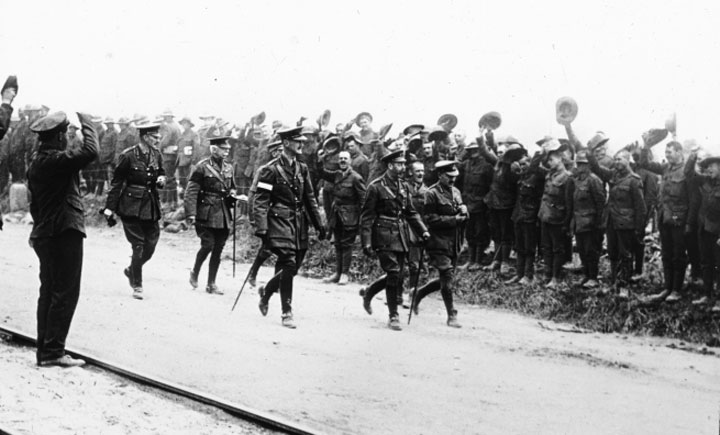MB367/148958, Victoria League of New Zealand Records, King George V, with Generals Godley, Plumer, and Harper, inspecting cheering New Zealand troops (British Official Photographer, Somme, France; August 1916).

King George V, with Generals Godley, Plumer, and Harper, inspecting cheering New Zealand troops

MB367/148958, Victoria League of New Zealand Records, King George V, with Generals Godley, Plumer, and Harper, inspecting cheering New Zealand troops (British Official Photographer, Somme, France; August 1916).
Depictions of soldiers were important in fostering personal emotional connections. Depictions of personalities were designed to achieve similar ends. Visits or images of personalities were intended to inspire those at the front, and those at home, to persevere and continue the war effort, and promote imperial unity.
This photograph, by an official British Photographer, depicts King George V, the central figure, accompanied by Generals Godley, Plumer, and Harper, inspecting a group of cheering New Zealand soldiers, during the Battle of the Somme. This photograph reflects the importance of ‘personalities’ in First World War propaganda, especially in promoting imperial unity. British propagandists were quick to realise the importance of George V as a propaganda personality, especially in calming discontent, and inspiring troops. On the British home front, the king was sent on visits to industrial areas in the north of England, with discontented workers generally gratified and encouraged by his visits. George V was equally important in imperial propaganda. Loyalty to the king was a way for dominions such as New Zealand to display their unity with Britain, and their commitment to the empire. Approval of the king was also interpreted as validating the sacrifices of New Zealand, and the reinforcing the importance of its contribution, which was important to depict to New Zealand citizens. This is reflected in the enthusiastic welcome the New Zealand troops are seen to be giving to the king. The presence of General Godley, the commander of the First and Second Anzac Corps, would also have been gratifying. Both of these personalities would have been recognisable to a New Zealand audience. This was significant, as this image was taken close to New Zealand’s debut in the Battle of the Somme, in the Battle of Flers-Courcelette. A visit from the king would therefore have been intended to encourage and validate the New Zealand troops, about to contribute to the campaign. However, such images of imperial unity were also useful to a wider audience. Images of enthusiastic imperial soldiers allowed British propagandists to present the empire as strongly united, and committed to the British cause.